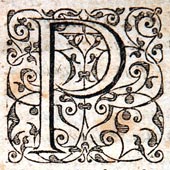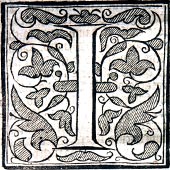Cabinet 12: Arabesque Initials

Arabesque designs, such as the P on display, are acknowledged by Alexander Nesbitt as being popular in the latter half of the 16th century. Through a comparison made of plate 65 in Nesbitt's Decorative Alphabets and Initials, the P can be tentatively identified as possibly being a design used by Jean Crespin at Geneva. Antonio Agustin's Antonii Avgvstini archiepiscopi contains numerous examples of arabesque initials; not all of them appear to be from the same set of decorative lettering.
Antonio Agustin, Antonii Avgvstini archiepiscopi Tarraconensis De legibvs, et Senatvsconsvltis liber. Cvm notis Fvlvii Vrsini,mvlto qvam antea emendatius, additis etiam locorum quorundam notis. Lvgdvni, Apud Franciscum Fabrum, CIC IC XCII Shoults Fb 1592 A

The large initial I beginning the section 'A sermon of good workes, annexed unto Fayth' in Certaine sermons is an example of a bold simplified arabesque design.

